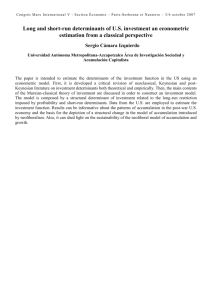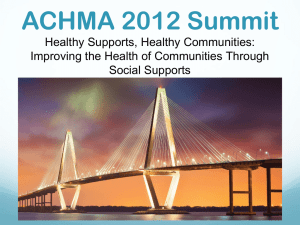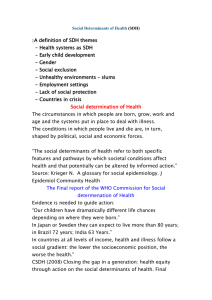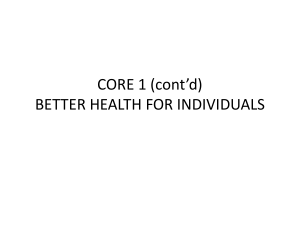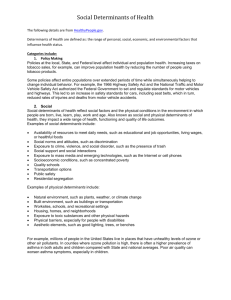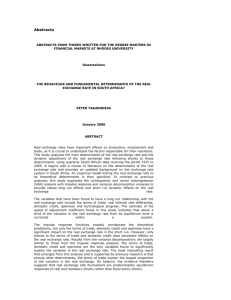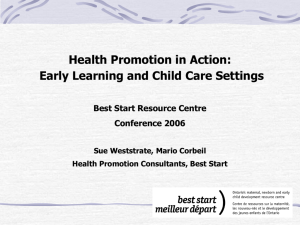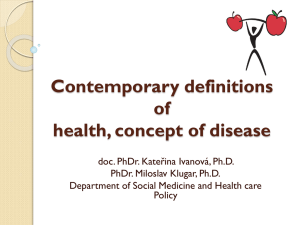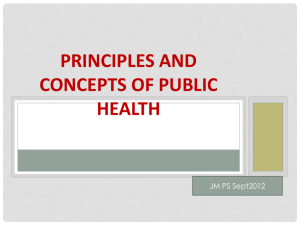Chapter 1 Potter
advertisement
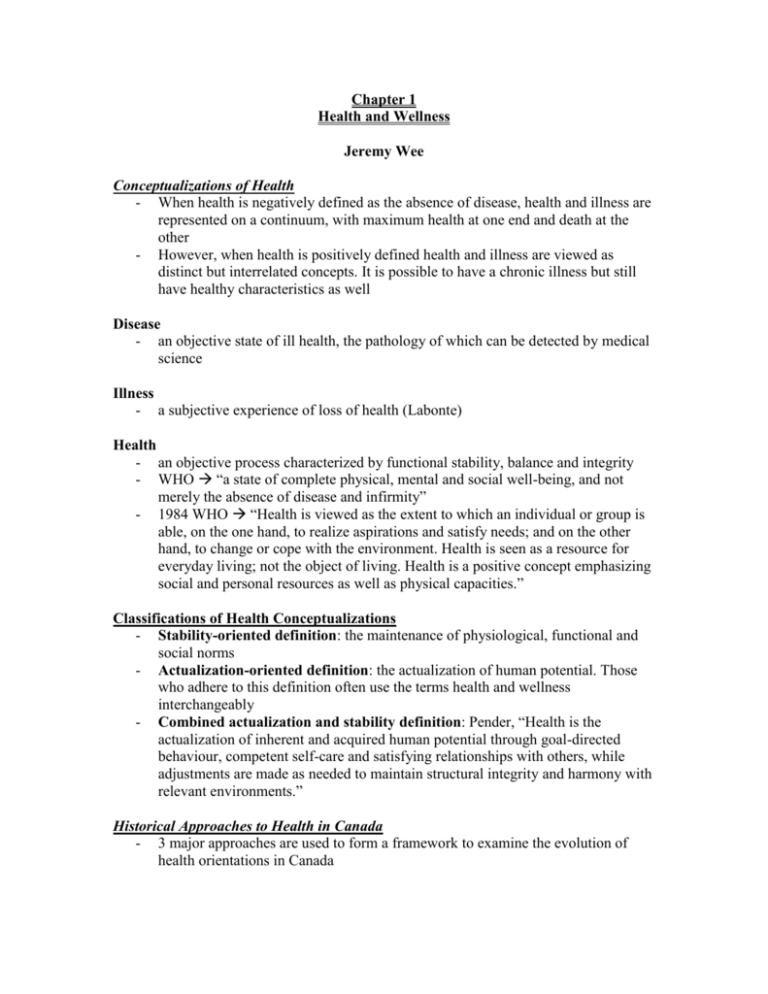
Chapter 1 Health and Wellness Jeremy Wee Conceptualizations of Health - When health is negatively defined as the absence of disease, health and illness are represented on a continuum, with maximum health at one end and death at the other - However, when health is positively defined health and illness are viewed as distinct but interrelated concepts. It is possible to have a chronic illness but still have healthy characteristics as well Disease - an objective state of ill health, the pathology of which can be detected by medical science Illness - a subjective experience of loss of health (Labonte) Health - an objective process characterized by functional stability, balance and integrity - WHO “a state of complete physical, mental and social well-being, and not merely the absence of disease and infirmity” - 1984 WHO “Health is viewed as the extent to which an individual or group is able, on the one hand, to realize aspirations and satisfy needs; and on the other hand, to change or cope with the environment. Health is seen as a resource for everyday living; not the object of living. Health is a positive concept emphasizing social and personal resources as well as physical capacities.” Classifications of Health Conceptualizations - Stability-oriented definition: the maintenance of physiological, functional and social norms - Actualization-oriented definition: the actualization of human potential. Those who adhere to this definition often use the terms health and wellness interchangeably - Combined actualization and stability definition: Pender, “Health is the actualization of inherent and acquired human potential through goal-directed behaviour, competent self-care and satisfying relationships with others, while adjustments are made as needed to maintain structural integrity and harmony with relevant environments.” Historical Approaches to Health in Canada - 3 major approaches are used to form a framework to examine the evolution of health orientations in Canada Medical Approach - Represents stability orientation to health - Emphasizes that medical intervention restores health - Less given to health promotion and disease prevention Behavioural Approach - When large amounts of money were spent on health care but the health status of the population did not improve proportionately, a report was commissioned to find out why - The Lalonde Report shifted emphasis from a medical to a behavourial approach to health o Broadly defined health determinants (health field concept) as: Lifestyle Environment Human biology The organization of health care - Aim was to decrease behavioural risk factors factors such as smoking, substance abuse, lack of exercise, and an unhealthy diet - Wanted to motivate individuals to engage in healthy behaviours Socio-Environmental Approach - Health is closely tied to the social structure. I.e. poverty and unhealthy physical and social environments can affect health directly - Health field concept was expanded to emphasize the social context of health and the relationship between personal health behaviours and social and physical environments - Ottawa Charter for Health Promotion supported a socio-environmental approach o Outlined 5 major strategies to promote health Building healthy public policy Creating supportive environments Strengthening community action Developing personal skills Reorienting health services o Identified prerequisites for health as: Peace Shelter Education Food Income Stable ecosystem Sustainable resources Social justice Equity - The Jakarta Declaration identified 4 additional prerequisites for health - Human rights Social security Social relations Empowerment of women The Epp Report identified 3 major health challenges influencing Canadians: Reducing inequities Improving prevention Enhancing coping Risk Factors and Risk Conditions o Psychosocial risk factors are complex psychological experiences resulting from social circumstances that include isolation, lack of social support, limited social networks, low self-esteem and self-blame o Socio-environmental risk conditions are social and environmental living conditions that include poverty, low educational or occupational status, dangerous or stressful work, dangerous physical environments, pollution, discrimination, relative political or economic powerlessness and inequalities of income or power Strategies for Population Health - Refer to Figure 1-5 for Population Health Approach - The entire range of known individual and collective factors and conditions that determine population health status, and the interactions among them, are taken into account in planning action to improve health - The key health determinants identified in this document are: o Income and social status o Social support networks o Education o Employment and working conditions o Physical environments o Biology and genetic endowment o Personal health practices and coping skills o Healthy child development o Health services Toronto Charter - Social determinants of health outlined in charter: o Early childhood development o Education o Employment and working conditions o Food security o Health care services o Housing shortages o o o o Income and equitable distribution Social safety nets Social exclusion Unemployment and employment security Determinants of Health - 12 major determinants of health, each influences the others: o Income and Social Status Greatest determinant of health Studies show Canadians who live in poverty have poorer health People with lower incomes are more likely to die earlier and to suffer more illnesses than those with higher incomes, regardless of age, sex, race, culture and place of residence o Social Support Networks Affects health, health behaviours, and health care utilization Support from families and friends and from informal and formal groups can provide practical aid during times of crisis and emotional support in times of distress and change o Education Important influence of health status because they affect may other health determinants Increases job opportunities and income security, giving one the knowledge and skills to solve problems and gain a sense of control over one’s life People with higher education levels tend to smoke less, be more physically active, and have access to healthier foods and physical environments o Employment and Working Conditions Significantly affect physical, mental and social health Paid work provides financial stability, a sense of identity and purpose, social contacts and opportunities for personal growth However, working conditions can also pose significant hazards Work pace and time are also key influences, especially among professionals and managers Workplace stress is linked to increased risk of physical injuries at work, high blood pressure, cardiovascular disease, depression and increases in smoking and drinking o Physical Environments Housing, indoor air quality and community planning are important determinants of health Affordable and adequate housing is another important aspect of the environment o Biology and Genetic Endowment Heredity is strongly influenced by social and physical environments, and considerable effort has been expended to o o o o o o prevent congenital defects through monitoring and improved preconception and prenatal care One should ask how much of a decline is related to biological aging and how much is the result of other determinants such as socio-economic status, social support and personal health practices Personal Health Practices and Coping Skills Personal health practices are the primary focus of the behavioural approach to health. Effective coping skills help people to face challenges without resorting to risk behaviours such as substance abuse 3 lifestyle practices with major detrimental health consequences are: Physical inactivity- promotes weight gain and obesity. It is a major risk for many diseases Poor nutrition- overconsumption of fats, sugars and starches is linked to major causes of diseases. Smoking- single most important preventable cause of death Healthy Child Development Important to lifelong health Conditions such as adequate and equitable income, effective parenting and supportive environments affect healthy child development 2 significant health risks are low birth weight and effects of maternal tobacco, alcohol and drug use Health Services Quality, accessible acute care treatment, long-term care, home care and preventive services are important to a population’s health status Gender Both men and women are susceptible to diseases; men are more likely to die prematurely from heart disease and cancer while women are more likely to suffer from depression and stress Gender-based social roles play a role in the health of each gender Culture Culture and ethnic factors influence how people interact with a health care system, their participation in programs of prevention and health promotion, their access to health information, their health-related lifestyle choices and their understanding of health and illness Language barriers can lead to isolation and decreased social support networks Prejudice can deny individuals opportunities for education, employment and access to housing Social Environments Defined as “the array of values and norms of a society that influence in varying ways the health and well-being of populations. In addition, social stability, recognition of diversity, safety, good working relationships and cohesive communities provide support that reduces or avoids many potential risks to good health” By reducing or effectively erasing one risk of health another health condition may increase i.e reducing income inequalities increases community cohesiveness Strategies to Influence Health Determinants - Refer to Harbinder’s Nurs 1110 notes on Health Promotion
